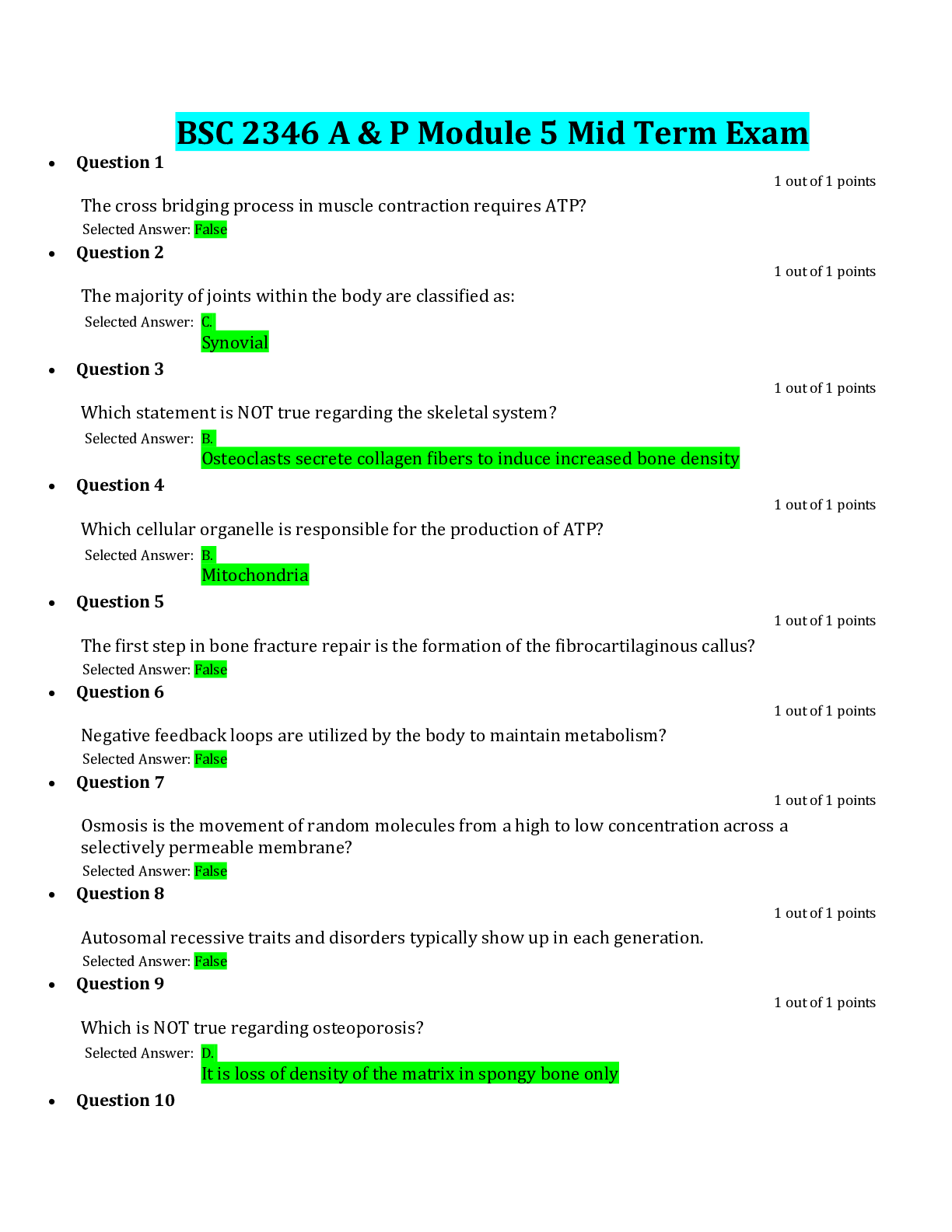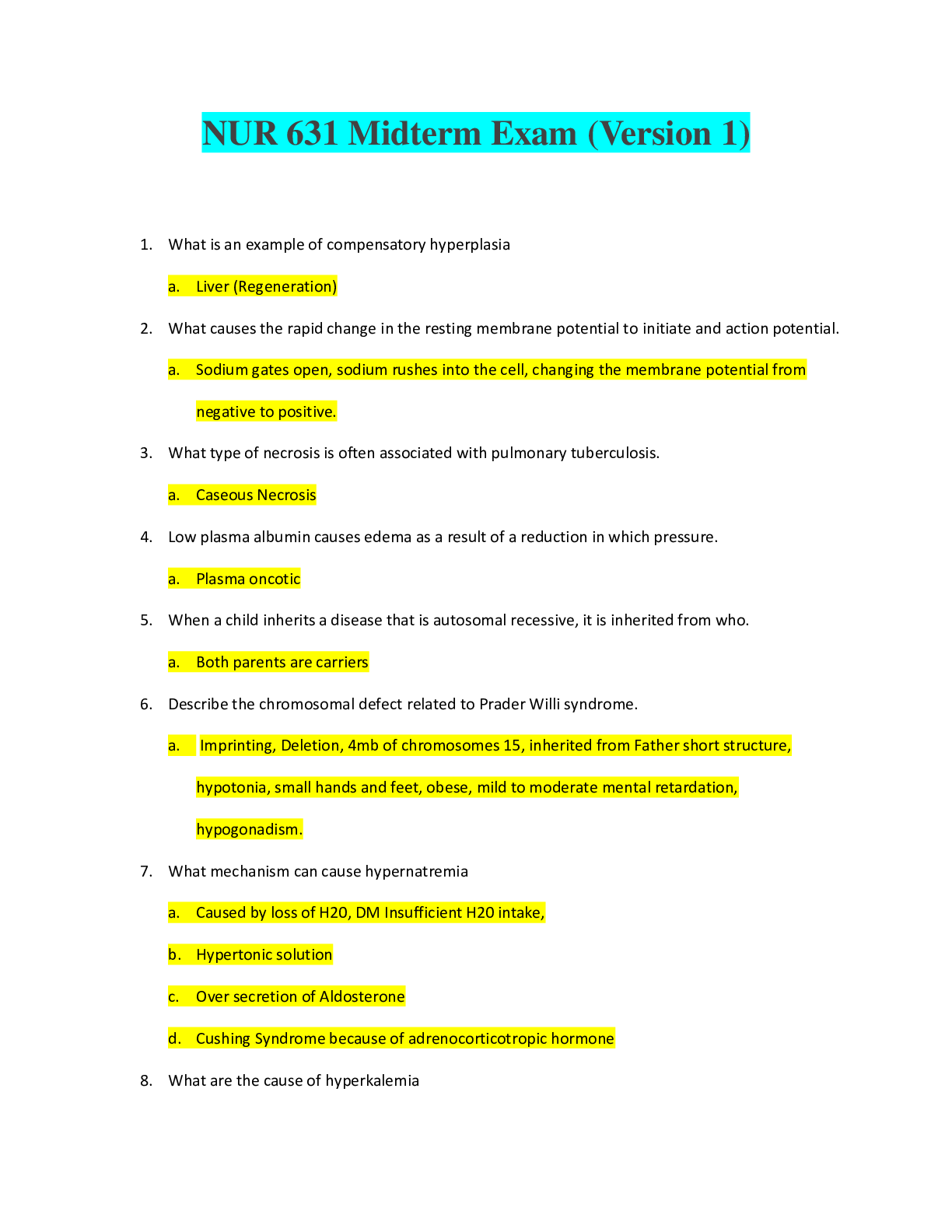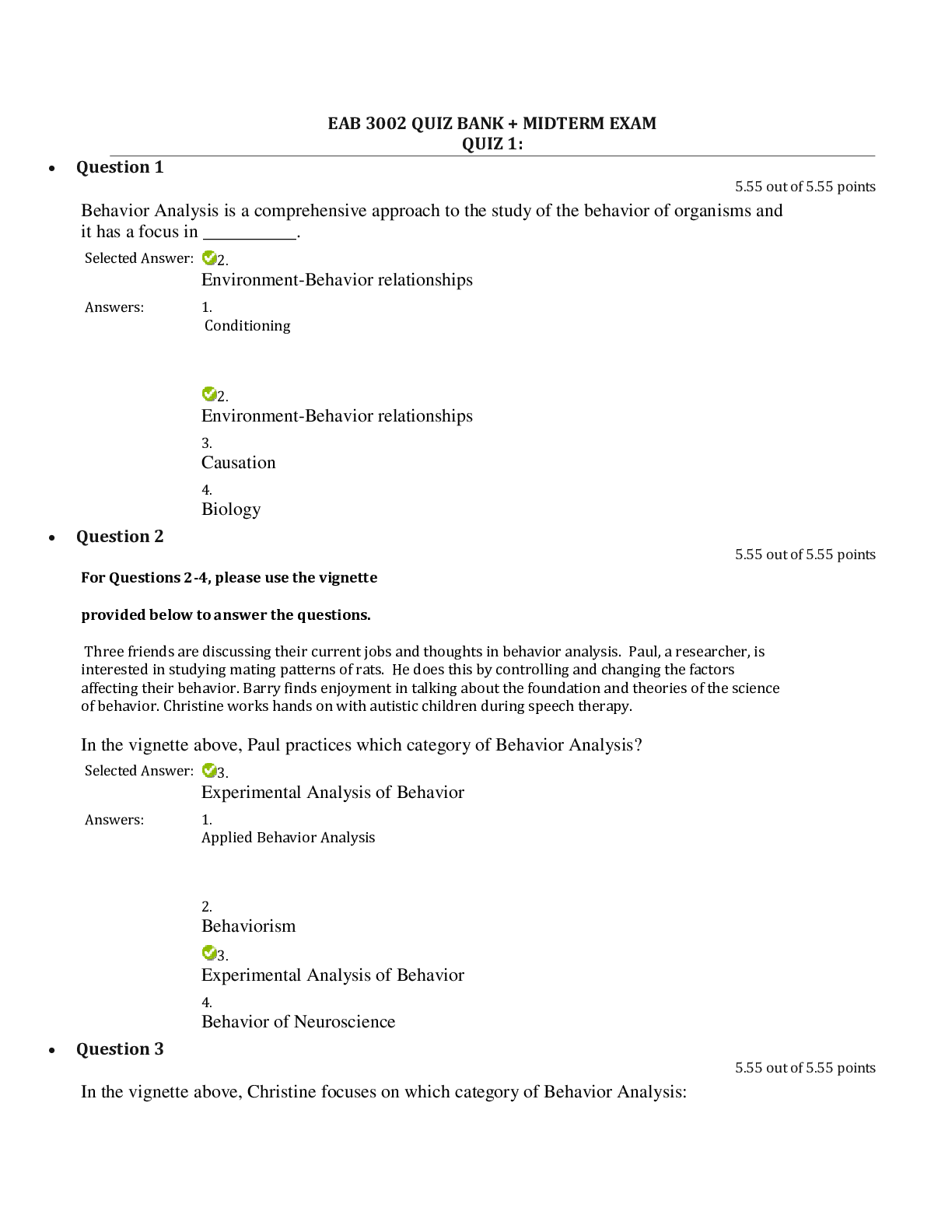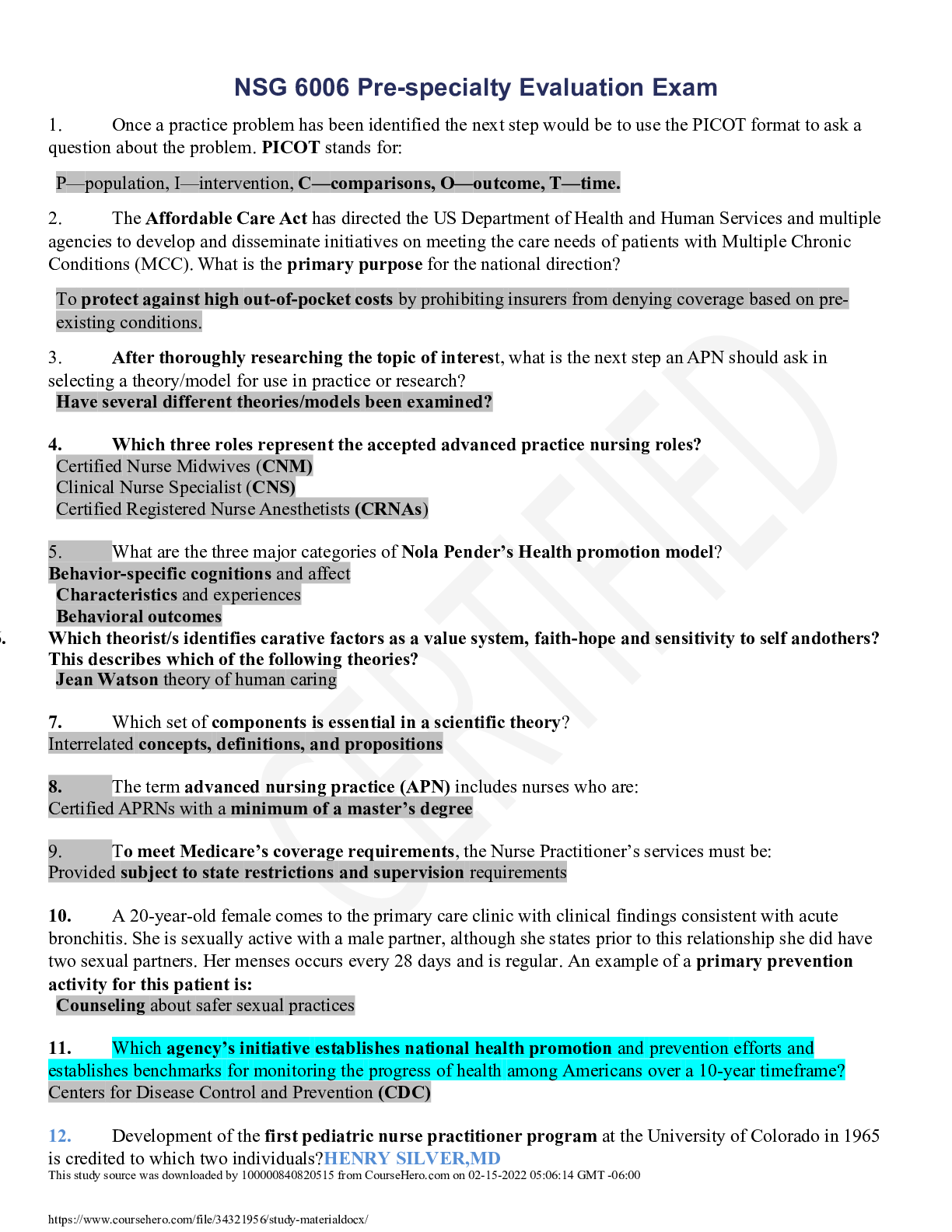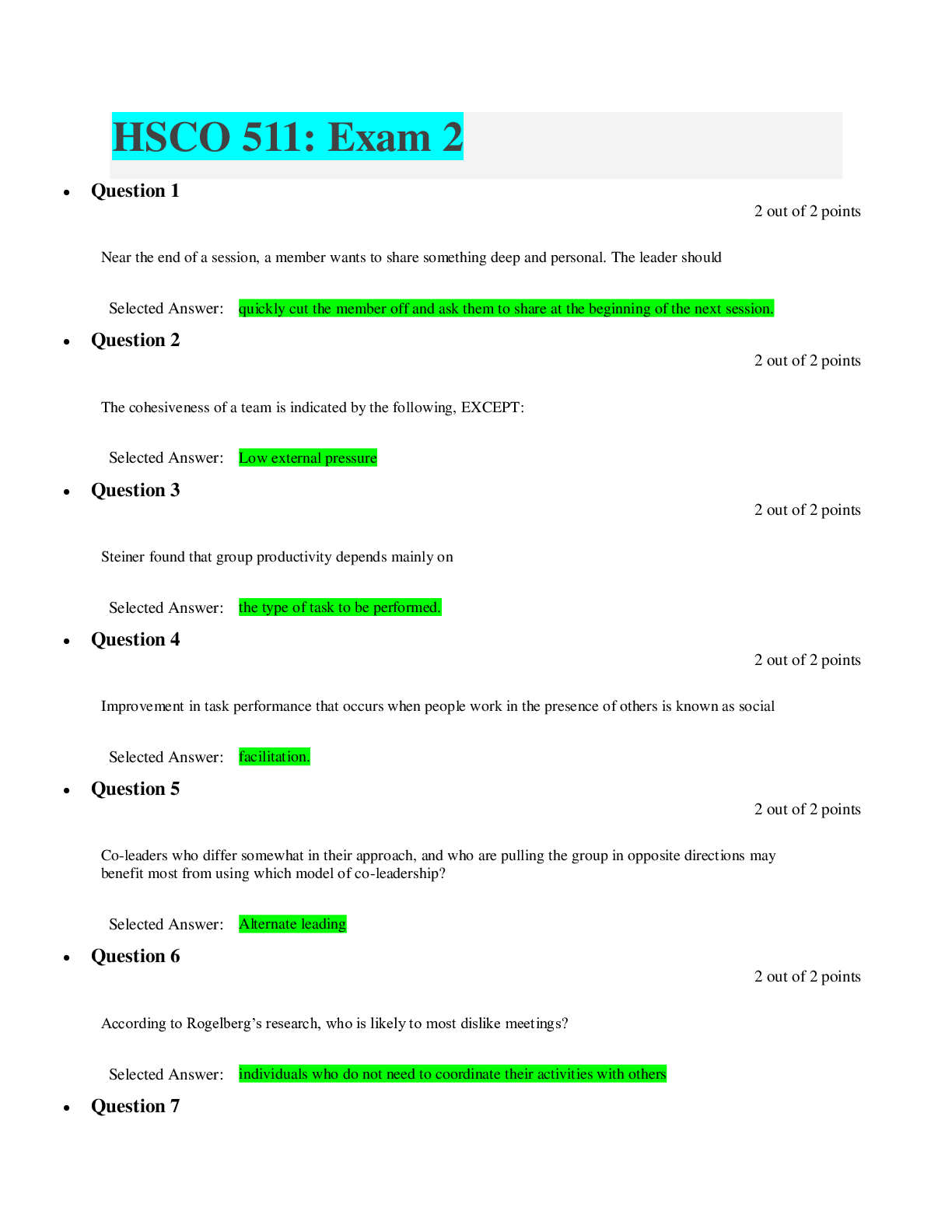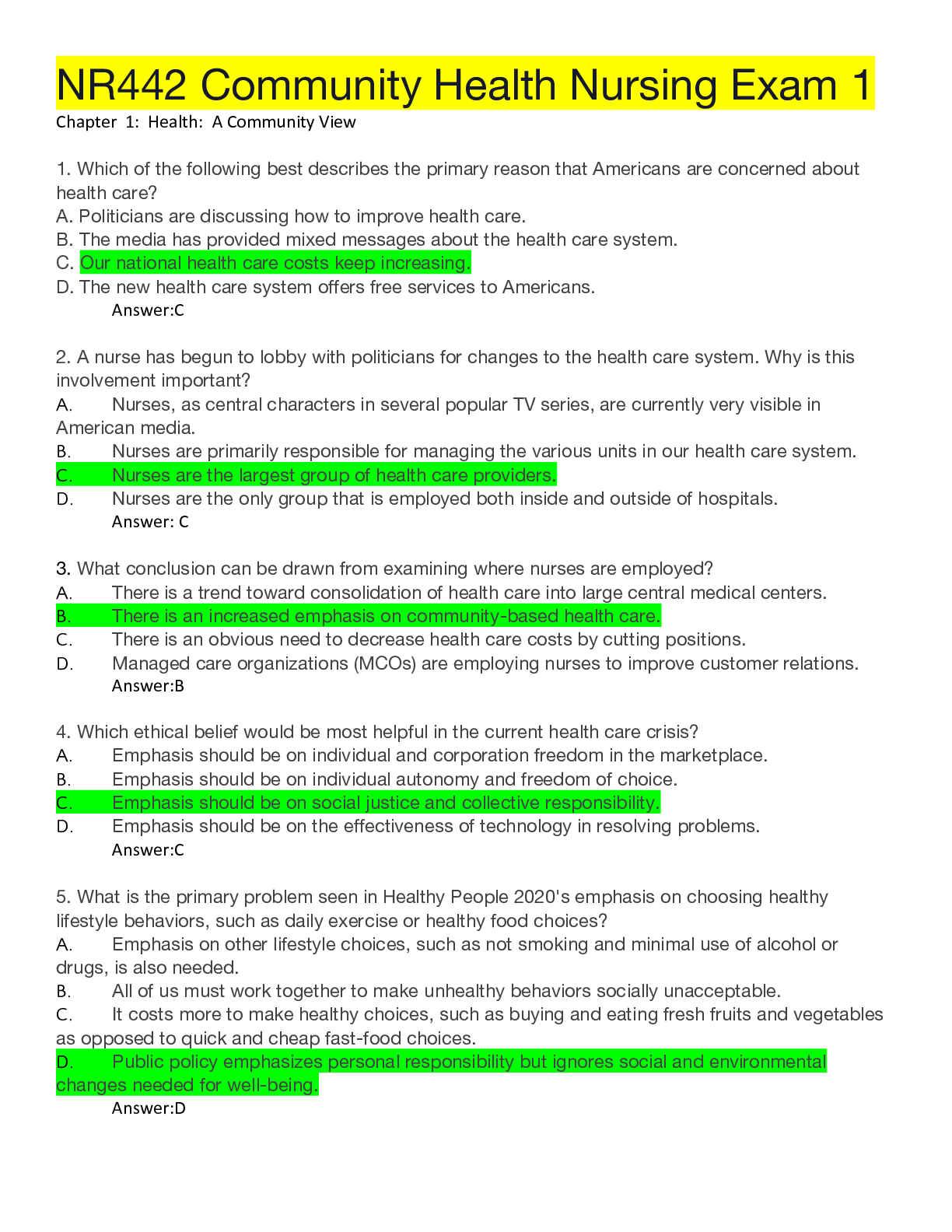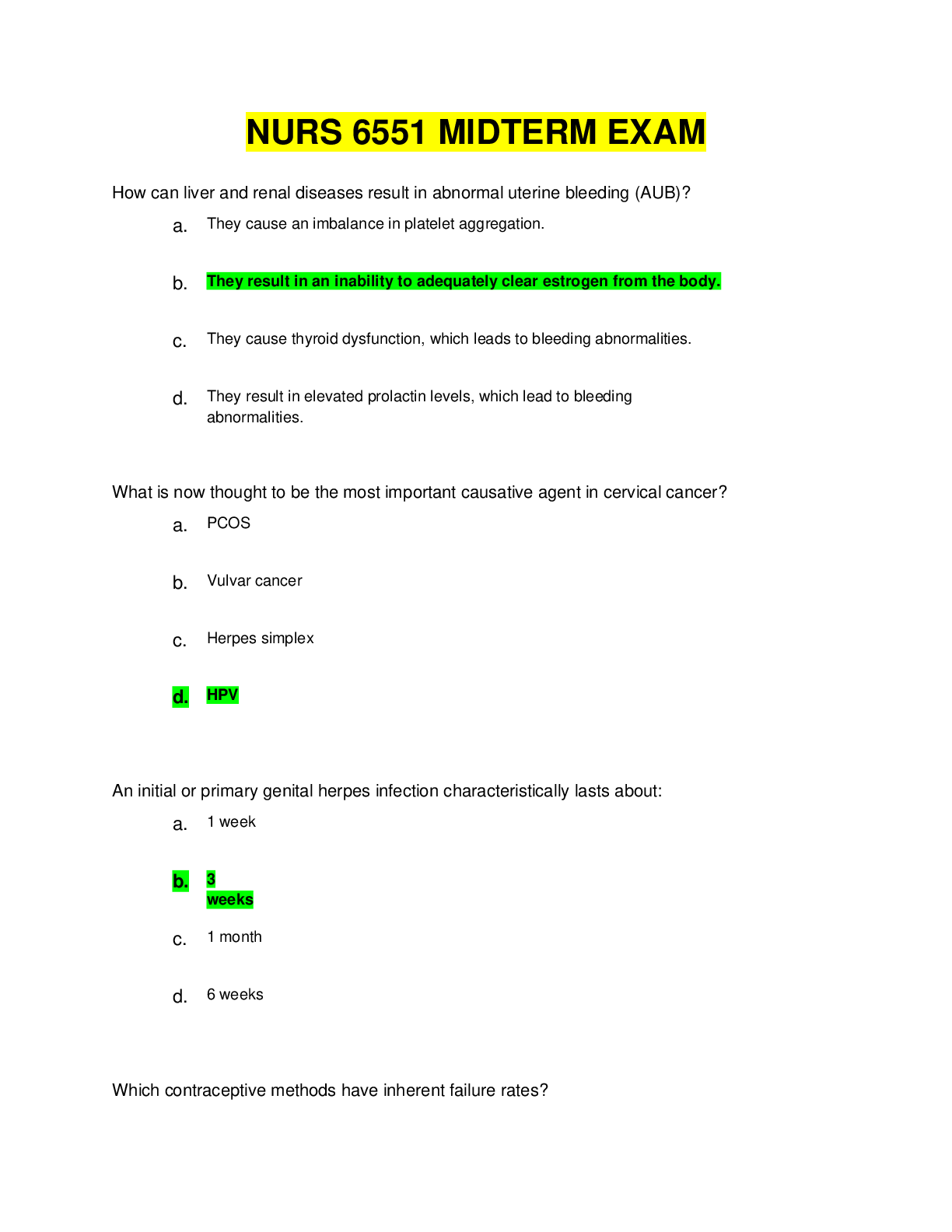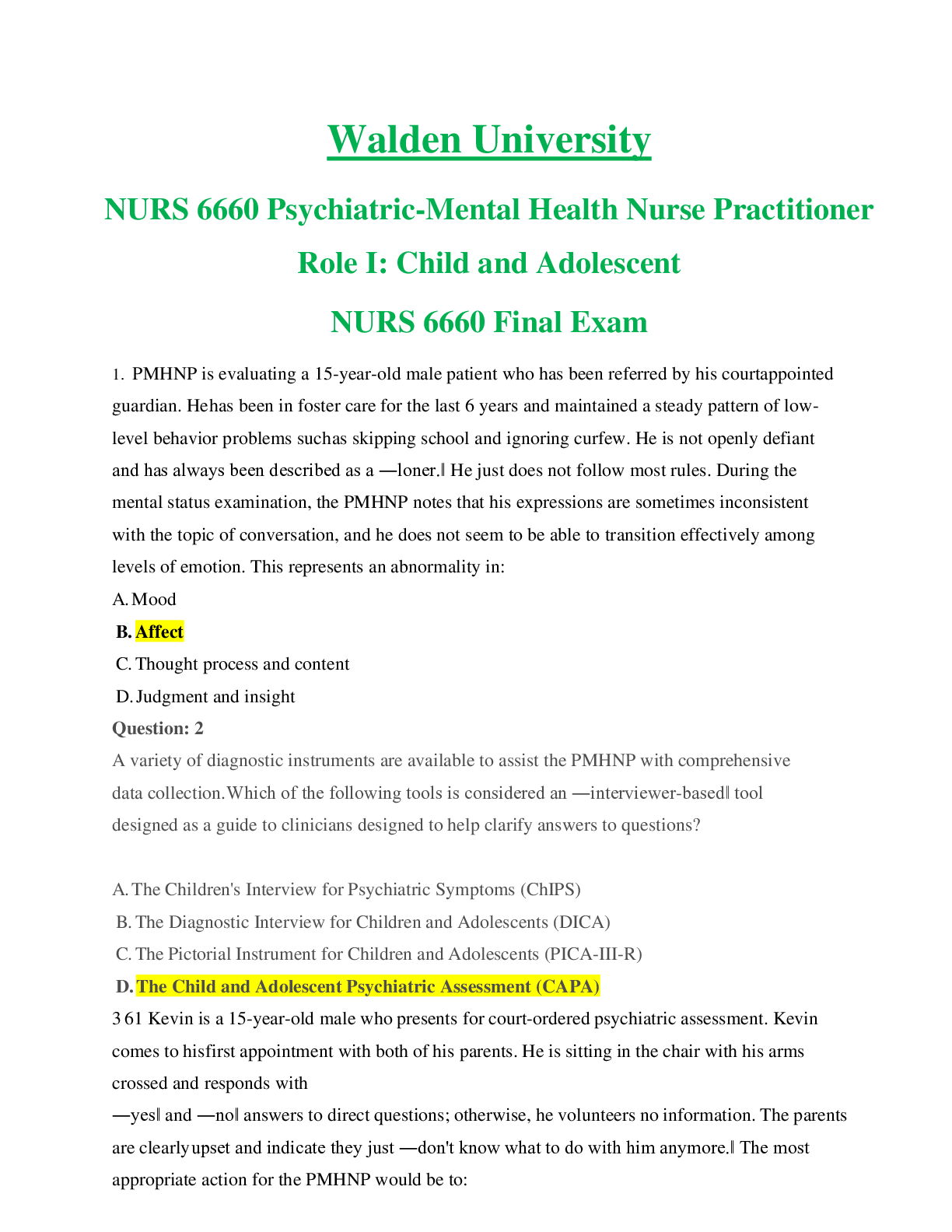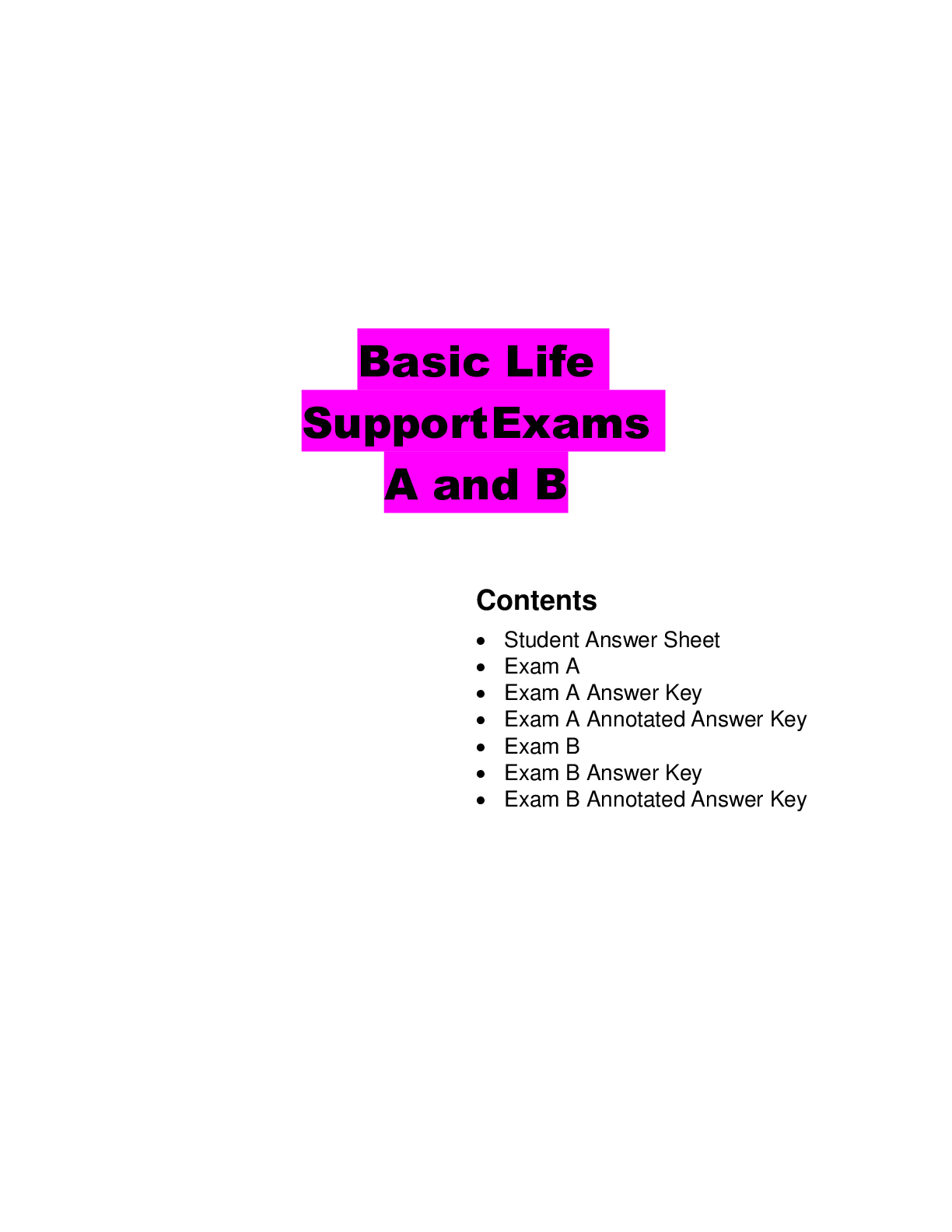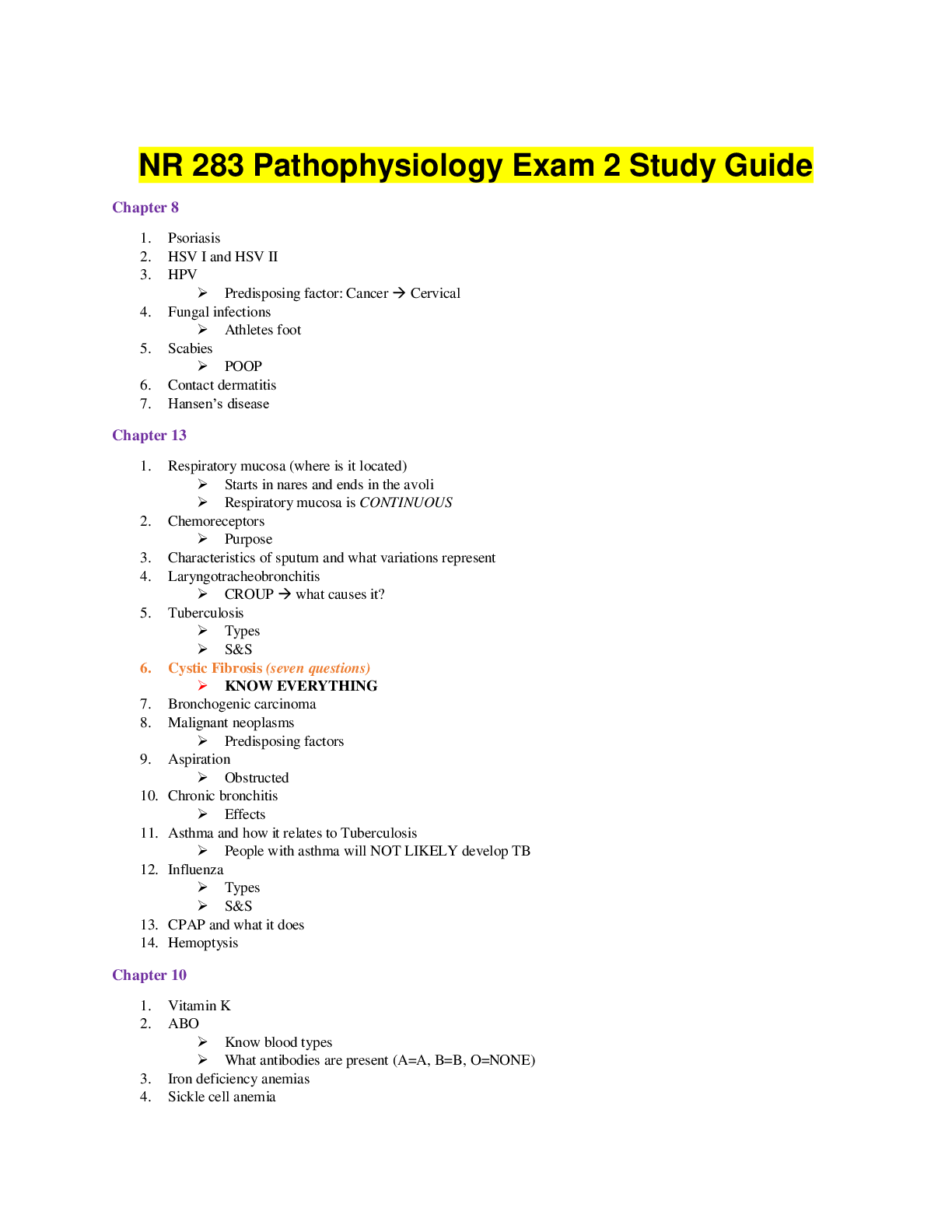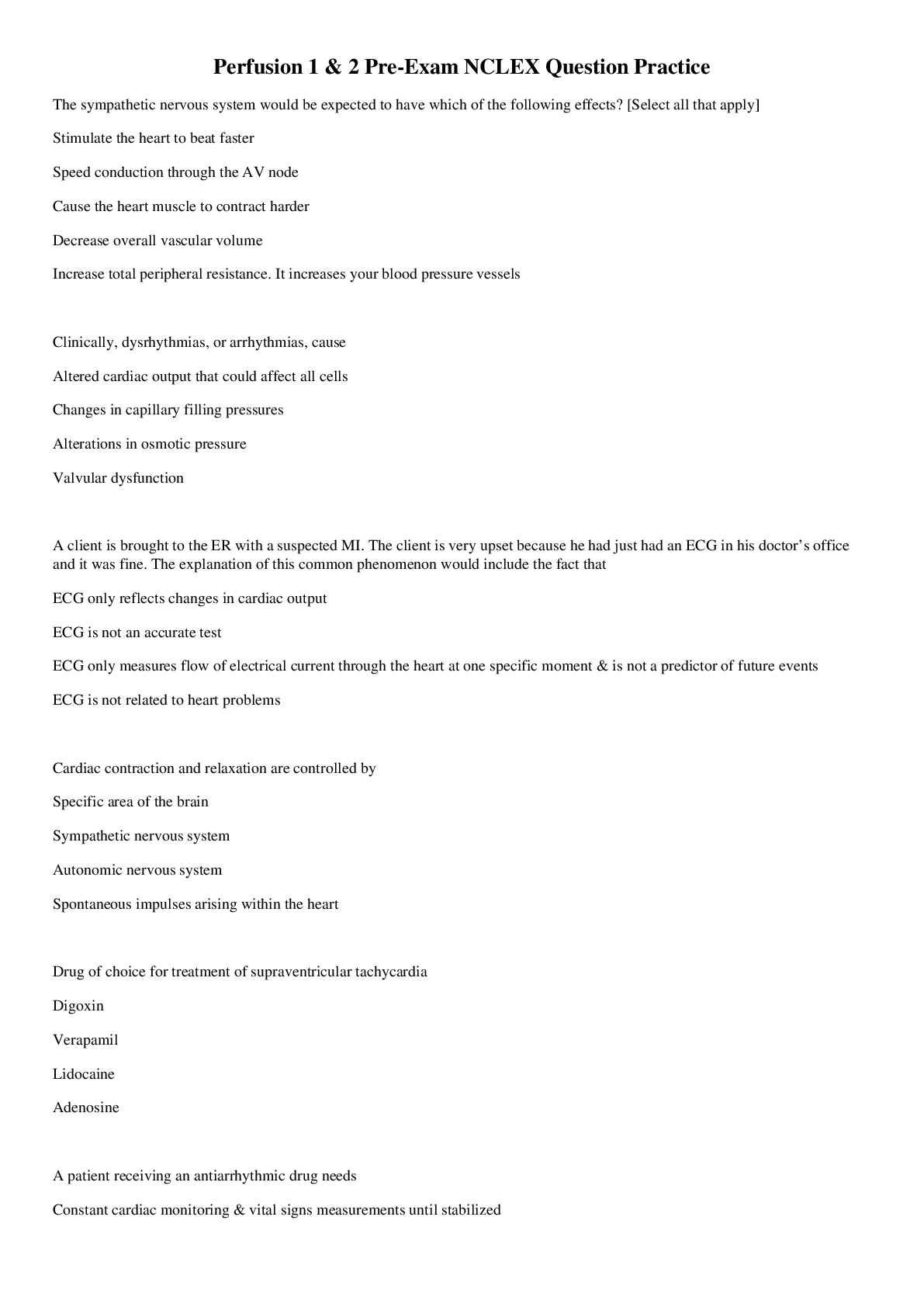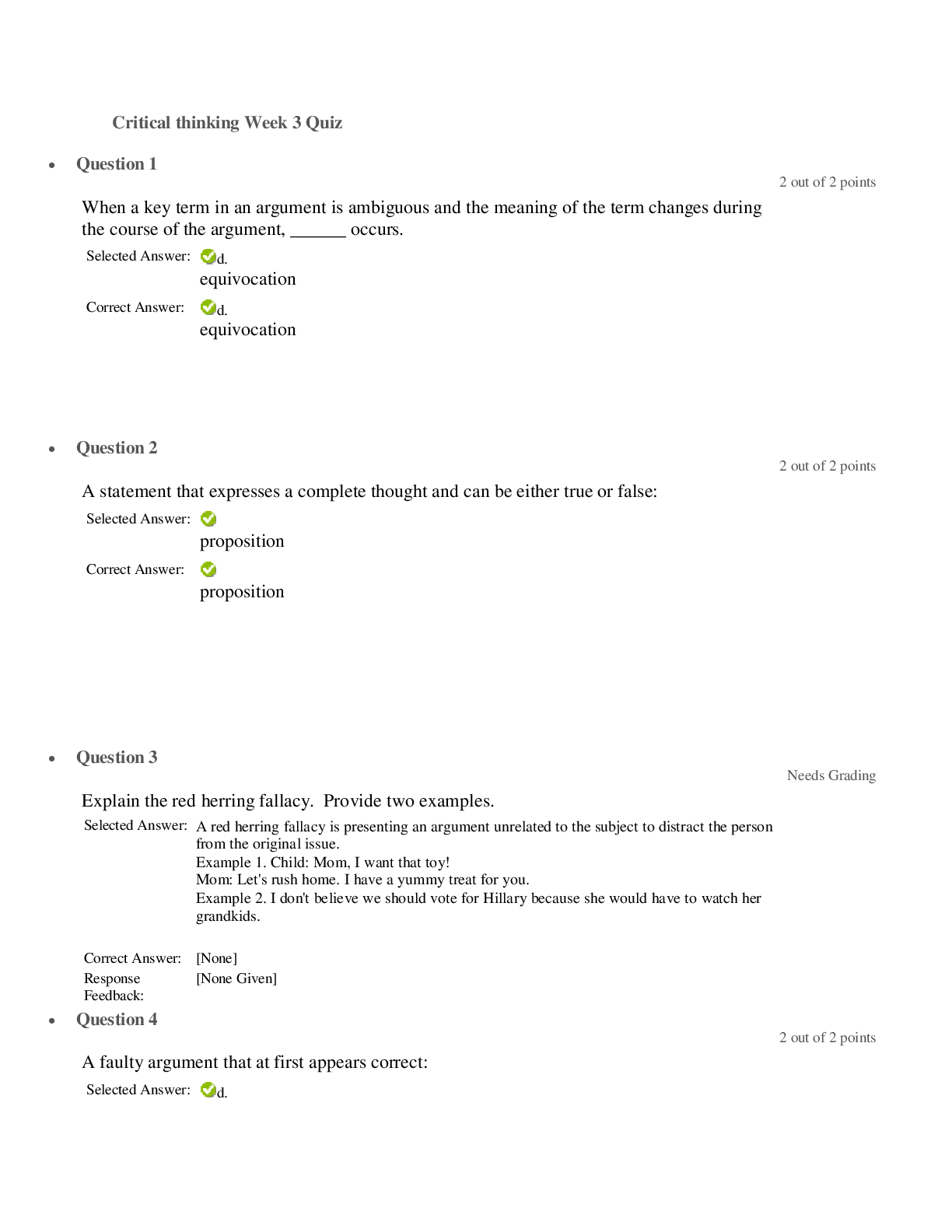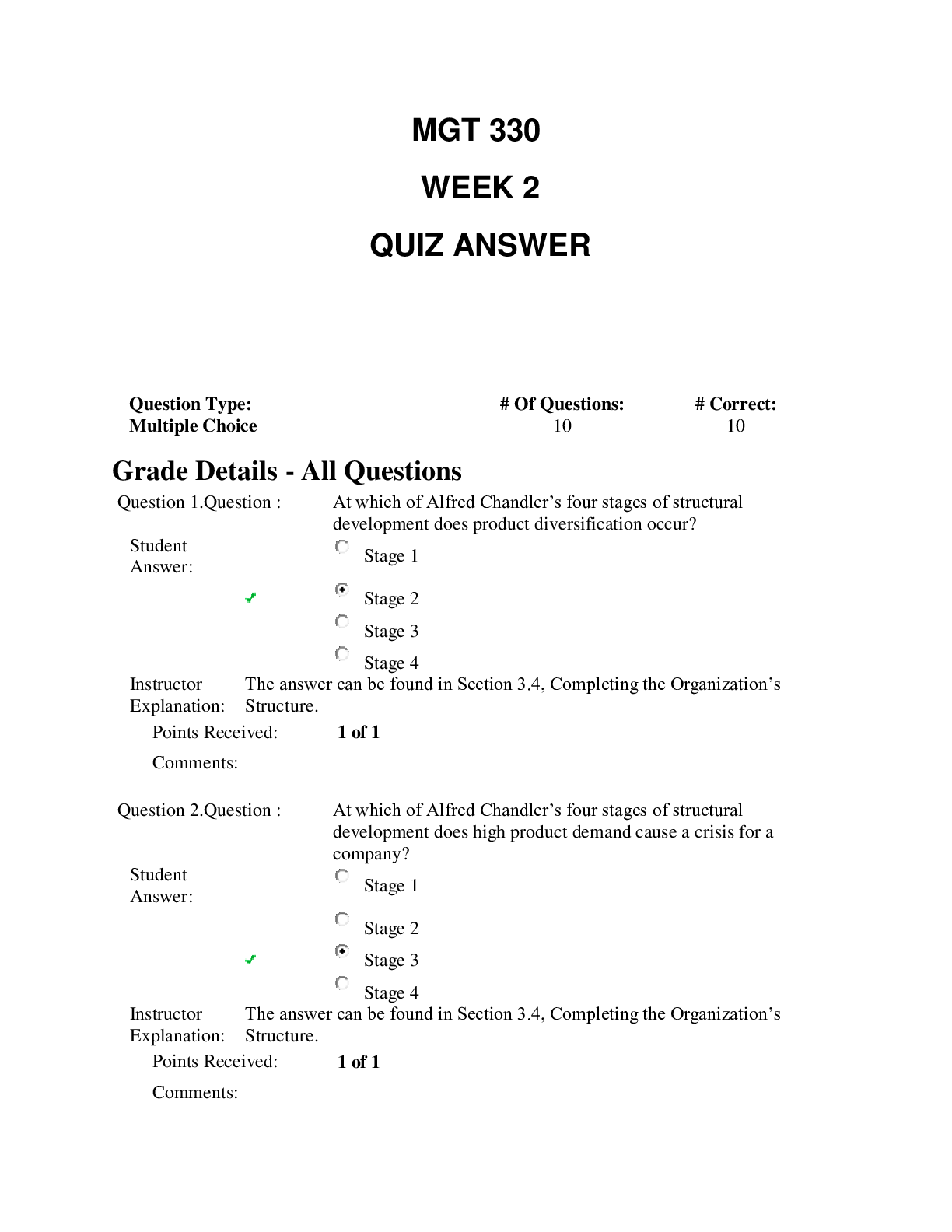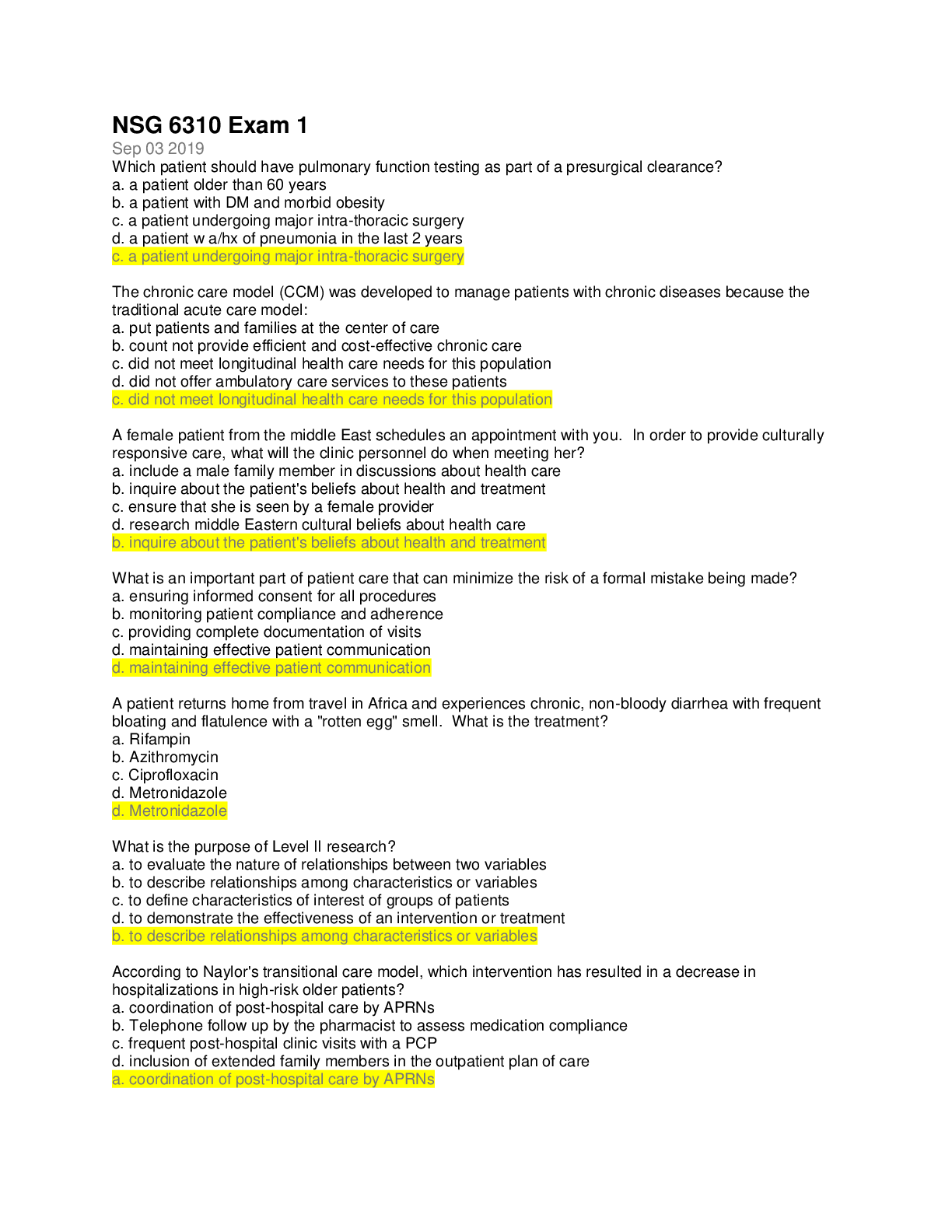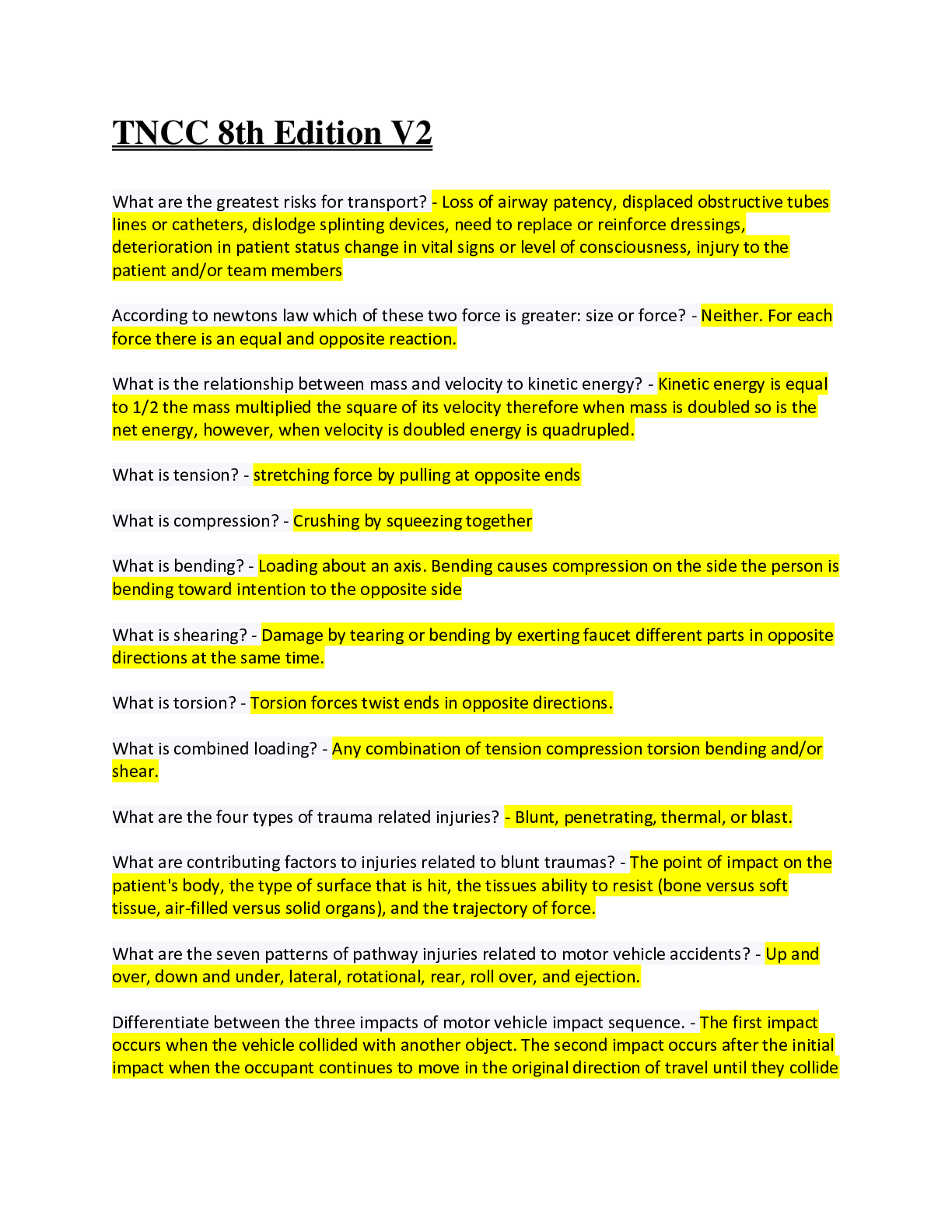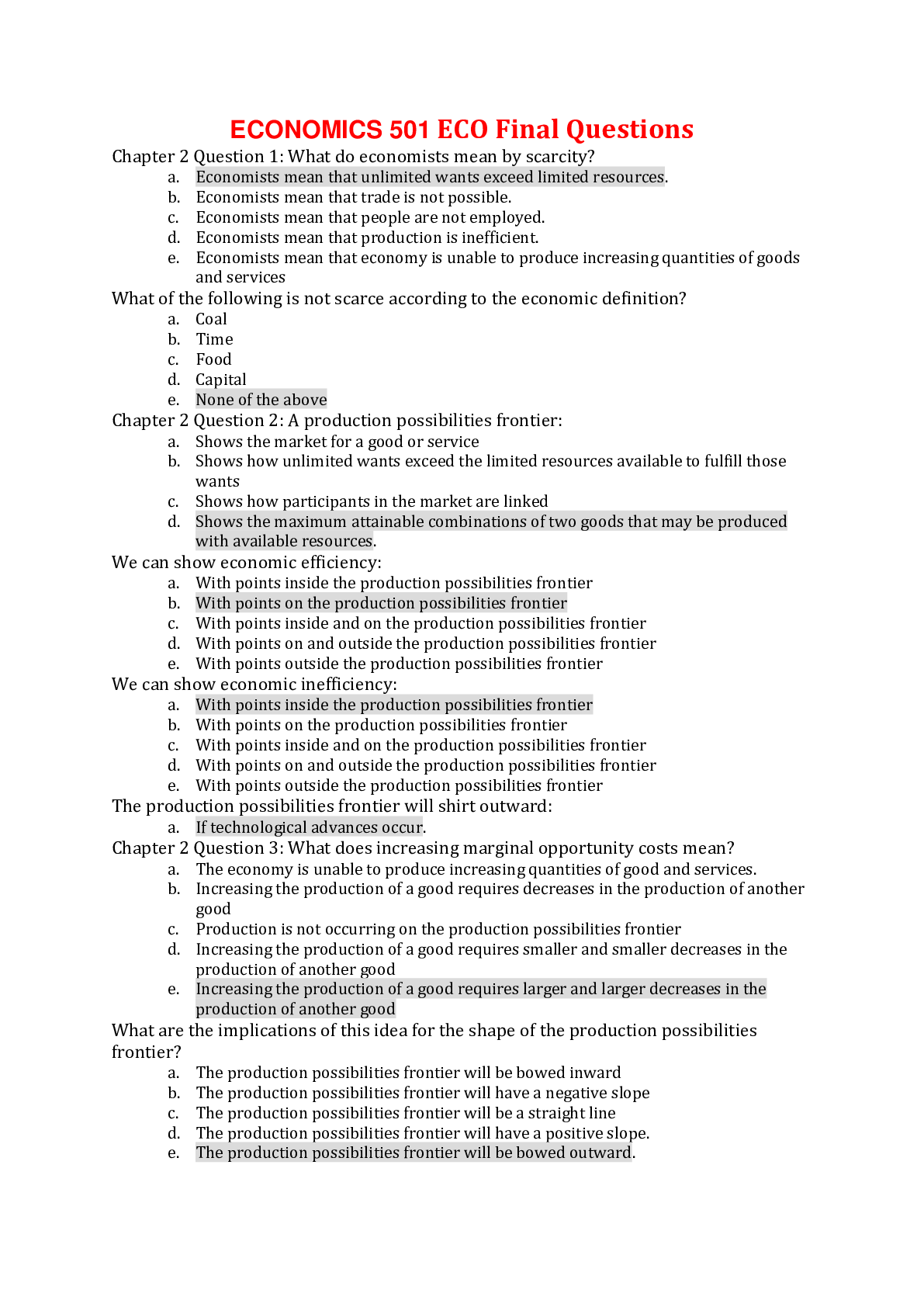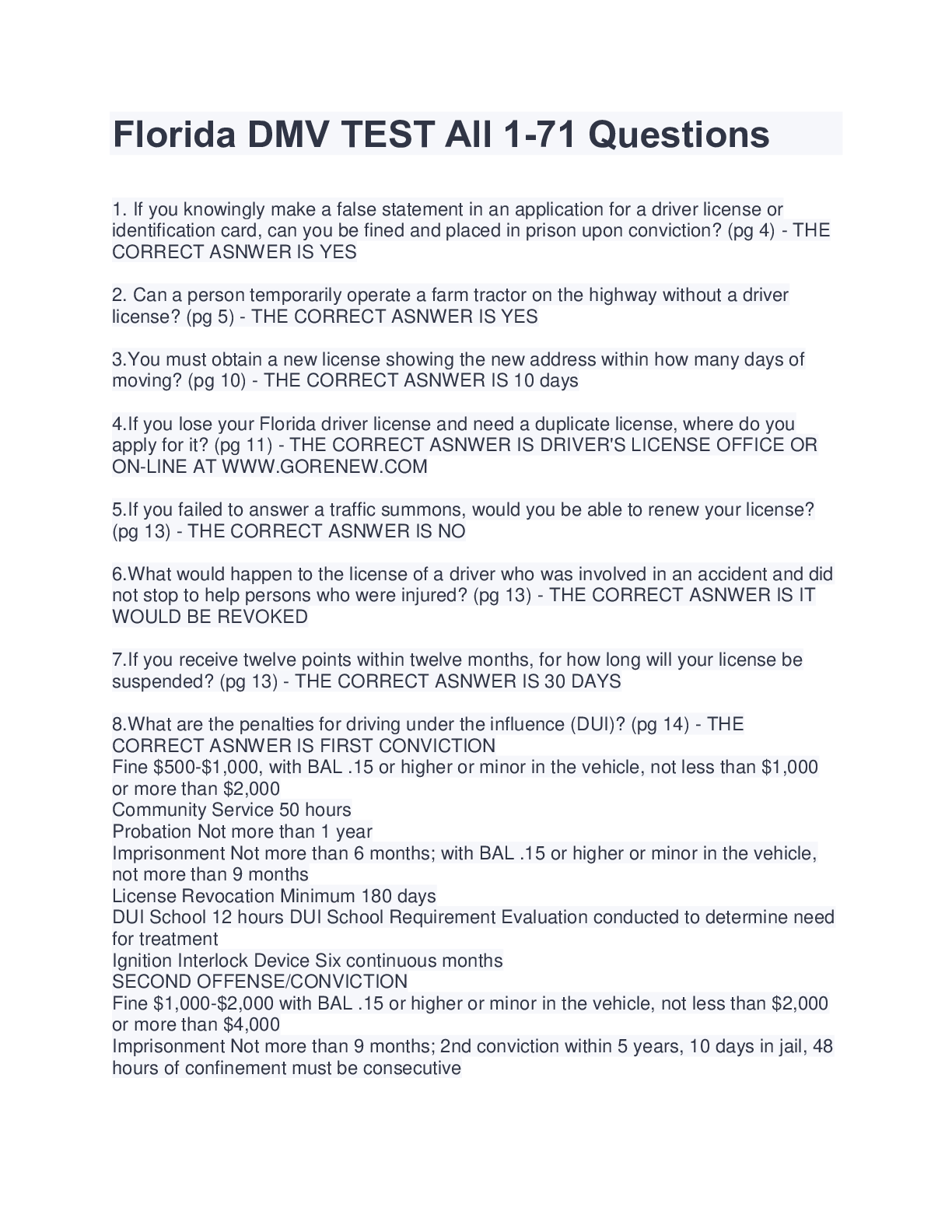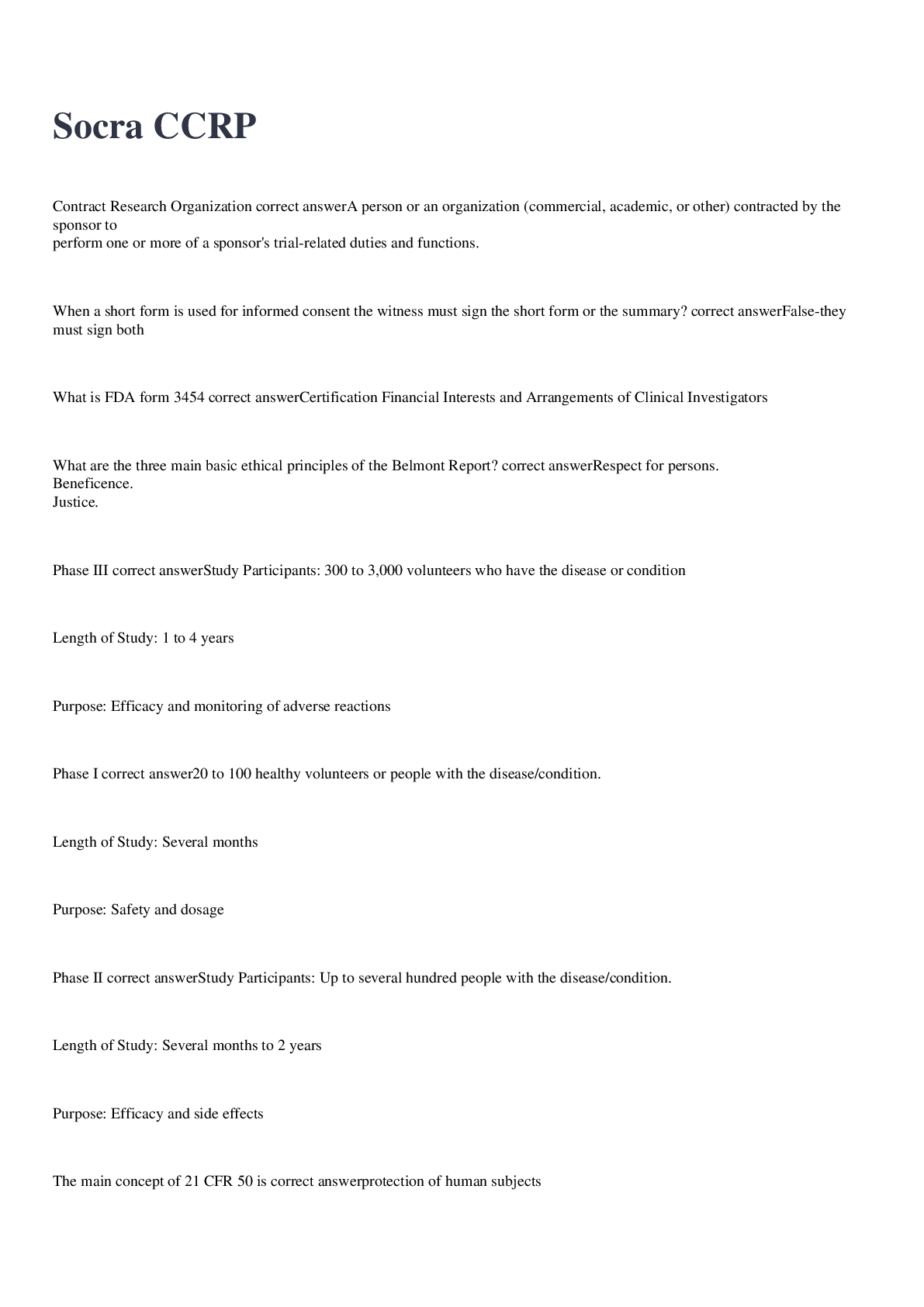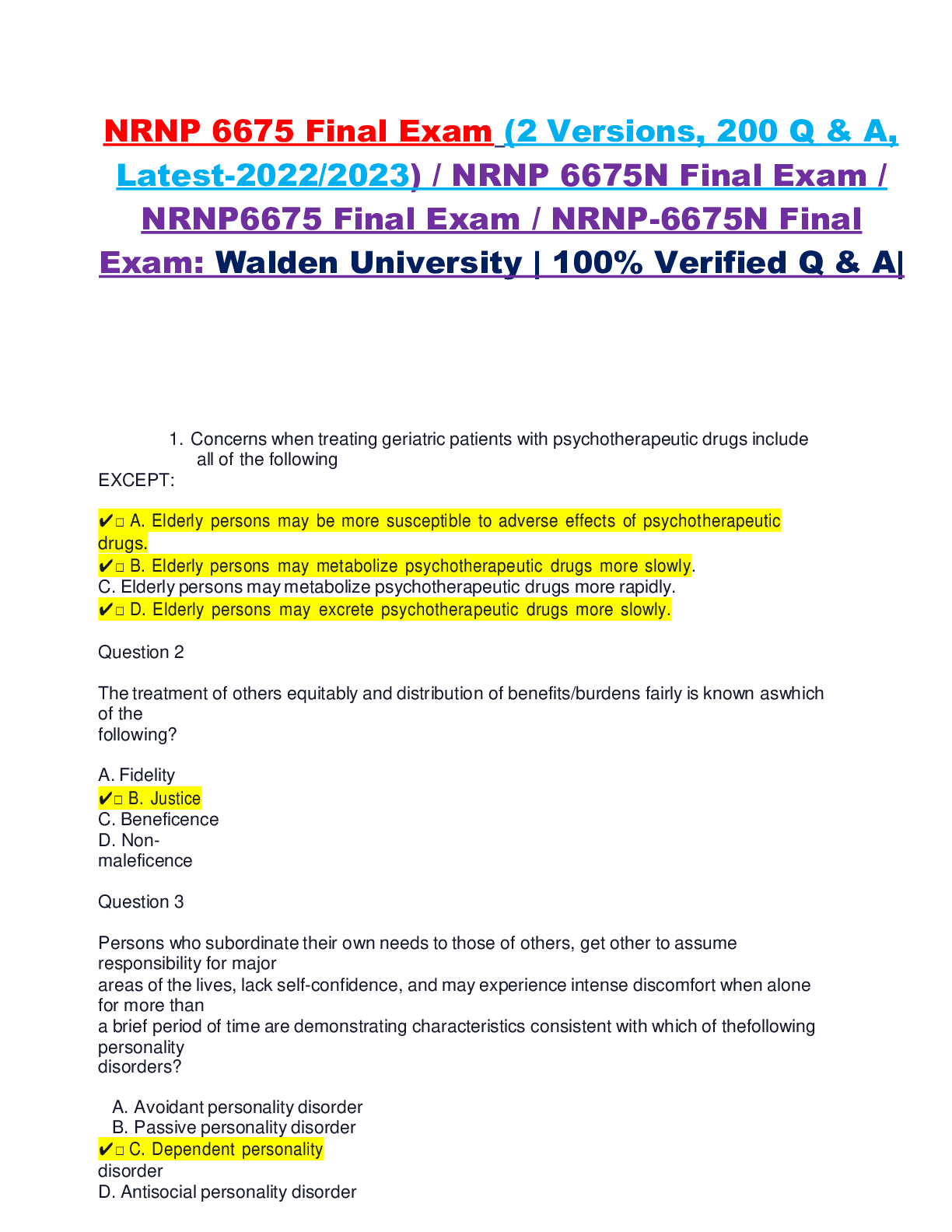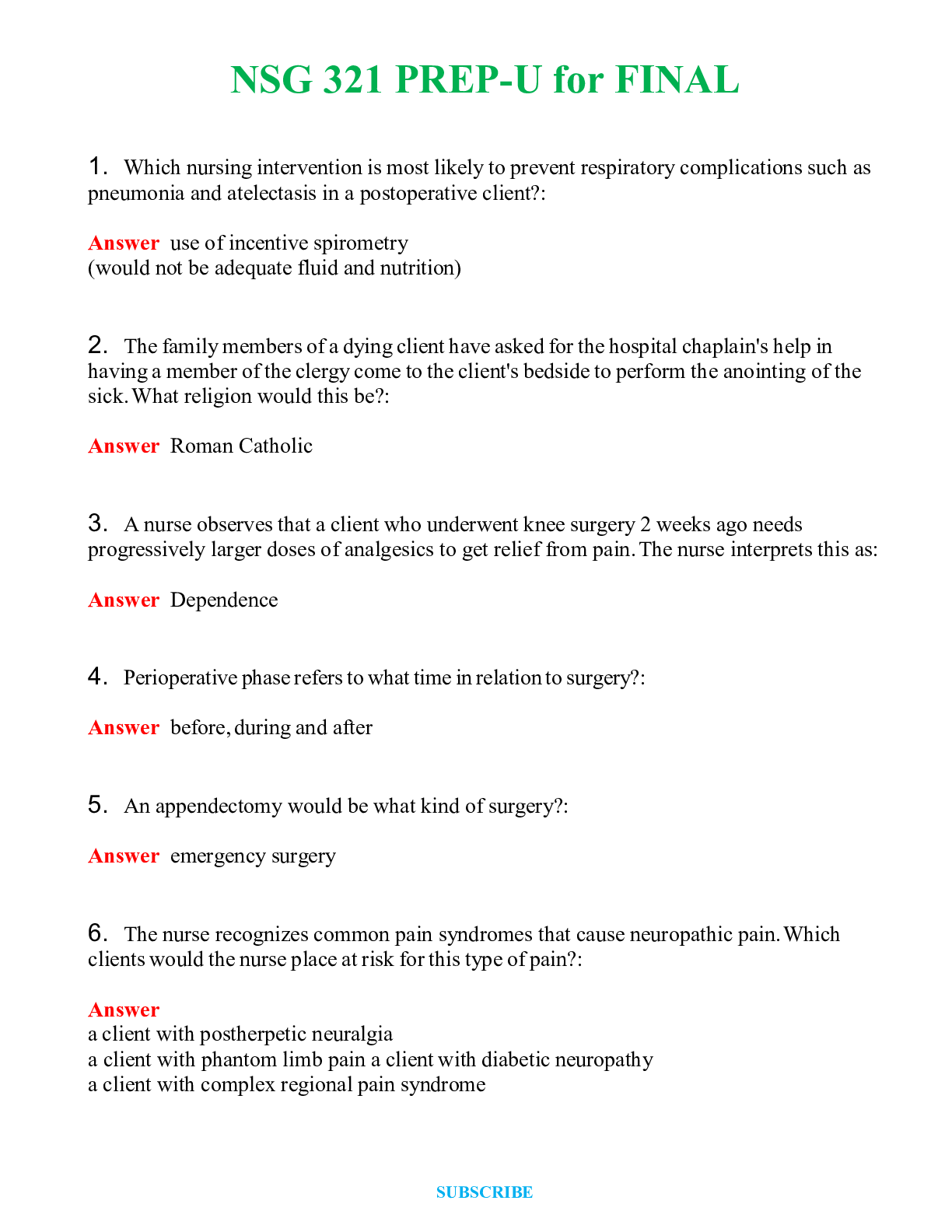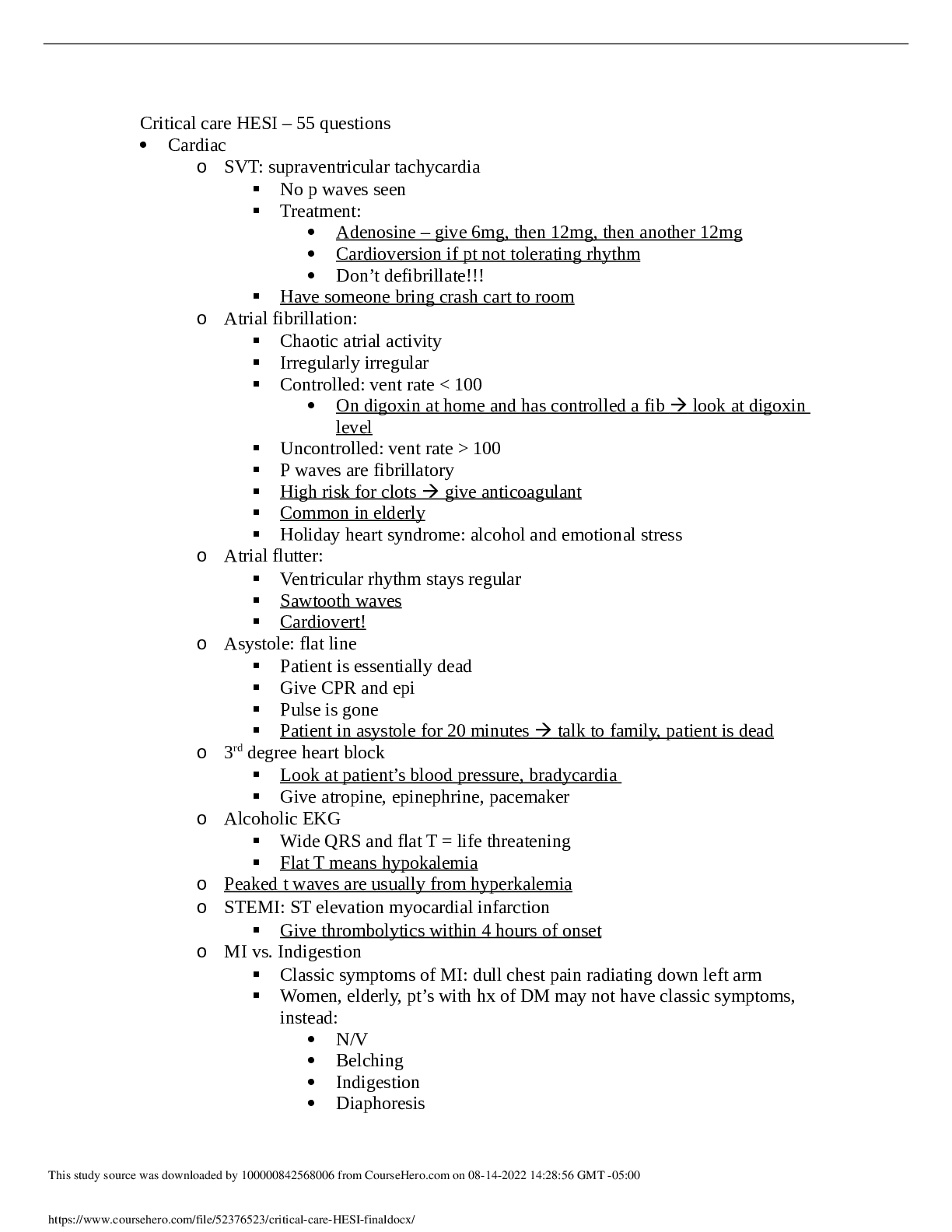> EXAM > NSG6420Quiz1 South University, Savannah (All)
NSG6420Quiz1 South University, Savannah
Document Content and Description Below
NSG6420 Quiz 1 Question 1: Which of the following is the most important question to ask during cardiovascular health history? a) Number of offspring b) Last physical exam c) Sudden death of a fa... mily member d) Use of caffeine Instructor Explanation: The sudden death of a family member is an important question to ask in the health history because it reveals the cardiovascular disease risk of the patient. Sudden death is usually due to an acute cardiovascular event, such as myocardial infarction, cardiac dysrhythmia, or stroke. Family history is particularly important for cardiac assessment because CVD, HTN, hyperlipidemia, and other vascular diseases often have a familial association that is not easily ameliorated by lifestyle changes. If there are deaths in the family related to CVD, determine the age and exact cause of death, because CVD at a young age in the immediate family carries an increased risk compared with CVD in an elderly family member. Ask about sudden death, which might indicate a congenital disease such as Marfan's syndrome. This is especially important to ask during pre-sports physicals because sudden death in athletes is often related to congenital or familial heart disease. Familial hyperlipidemia is autosomal dominant and often leads to CAD and MI at a young age. Family history of obesity and type 2 diabetes are also secondary risk factors for heart disease because the familial tendency for these is strong. Ask about smoking in the house, as secondhand smoke is a risk factor for respiratory and cardiac disease. (Goolsby 167-168) Goolsby, Mary J., Laurie Grubbs. Advanced Assessment Interpreting Findings and Formulating Differential Diagnoses, 3rd Edition. F.A. Davis Company, 11/2014. VitalBook file. Points Received:2 of 2 Question 2. A key symptom of ischemic heart disease is chest pain. However, angina equivalents may include exertional dyspnea. Angina equivalents are important because: a) Women with ischemic heart disease many times do not present with chest pain b) Some patients may have no symptoms or atypical symptoms; diagnosis may only be made at the time of an actual myocardial infarction c) Elderly patients have the most severe symptoms d) A & B only Question 3.A 55-year-old post-menopausal woman with a history of hypertension complains of jaw pain on heavy exertion. There were no complaints of chest pain. Her ECG indicates normal sinus rhythm without ST segment abnormalities. Your plan may include: a) Echocardiogram b) Exercise stress test c) Cardiac catheterization d) Myocardial perfusion imaging Question 4.Jenny is a 24 year old graduate student that presents to the clinic today with complaints of fever, midsternal chest pain and generalized fatigue for the past two days. She denies any cough or sputum production. She states that when she takes Ibuprofen and rest that the chest pain does seem to ease off. Upon examination the patient presents looking very ill. She is leaning forward and states that this is the most comfortable position for her. Temp is 102. BP= 100/70. Heart rate is 120/min and regular. Upon auscultation a friction rub is audible. Her lung sounds are clear. With these presenting symptoms your initial diagnosis would be: a) Mitral Valve Prolapse b) Referred Pain from Cholecystitis c) Pericarditis d) Pulmonary Embolus Question 5.Which symptom is more characteristic of Non-Cardiac chest pain? a) Pain often radiates to the neck, jaw, epigastrium, shoulder, or arm b) Pain tends to occur with movement, stretching or palpation c) Pain usually lasts less than 10 minutes and is relieved by nitroglycerine d) Pain is aggravated by exertion or stress Question 6.What is the most common valvular heart disease in the older adult? a) Aortic regurgitation b) Aortic stenosis c) Mitral regurgitation d) Mitral stenosis Question 7.Jeff, 48 years old, presents to the clinic complaining of fleeting chest pain, fatigue, palpitations, lightheadedness, and shortness of breath. The pain comes and goes and is not associated with activity or exertion. Food does not exacerbate or relieve the pain. The pain is usually located under the left nipple. Jeff is concerned because his father has cardiac disease and underwent a CABG at age 65. The ANP examines Jeff and hears a mid-systolic click at the 4th ICS mid-clavicular area. The ANP knows that this is a hallmark sign of: a) Angina b) Pericarditis c) Mitral valve prolapse d) Congestive heart failure Question 8.The aging process causes what normal physiological changes in the heart? a) The heart valve thickens and becomes rigid, secondary to fibrosis and sclerosis b) Cardiology occurs along with prolapse of the mitral valve and regurgitation c) Dilation of the right ventricle occurs with sclerosis of pulmonic and tricuspid valves d) Hypertrophy of the right ventricle Question 9.Dan G., a 65-year-old man, presents to your primary care office for the evaluation of chest pain and left-sided shoulder pain. Pain begins after strenuous activity, including walking. Pain is characterized as dull, aching; 8/10 during activity, otherwise 0/10. Began a few months ago, intermittent, aggravated by exercise, and relieved by rest. Has occasional nausea. Pain is retrosternal, radiating to left shoulder, definitely affects quality of life by limiting activity. Pain is worse today; did not go away after he stopped walking. BP 120/80. Pulse 72 and regular. Normal heart sounds, S1 and S2, no murmurs. Which of the following differential diagnoses would be most likely? a) Musculoskeletal chest wall syndrome with radiation b) Esophageal motor disorder with radiation c) Acute cholecystitis with cholelithiasis d) Coronary artery disease with angina pectoris Question 10.A common auscultatory finding in advanced CHF is: a) Systolic ejection murmur b) S3 gallop rhythm c) Friction rub d) Bradycardia Question 11.Your 35-year-old female patient complains of feeling palpitations on occasion. The clinician should recognize that palpitations are often a sign of: a) Anemia b) Anxiety c) Hyperthyroidism d) All of the above Question 12.The best way to diagnose structural heart disease/dysfunction non-invasively is: a) Chest X-ray b) EKG c) Echocardiogram d) Heart catheterization Question 13.During auscultation of the chest, your exam reveals a loud grating sound at the lower anterolateral lung fields, at full inspiration and early expiration. This finding is consistent with: a) Pneumonia b) Pleuritis c) Pneumothorax d) A and B Question 14.A 75-year-old patient complains of pain and paresthesias in the right foot that worsens with exercise and is relieved by rest. On physical examination you note pallor of the right foot, capillary refill of 4 seconds in the right foot, +1 dorsalis pedis pulse in the right foot, and +2 pulse in left foot. Which of the following is a likely cause of the signs and symptoms? a) Arterial insufficiency b) Femoral vein thrombus c) Venous insufficiency d) Peripheral neuropathy Question 15.Your patient complains of a feeling of heaviness in the lower legs daily. You note varicosities, edema, and dusky color of both ankles and feet. Which of the following is the most likely cause for these symptoms? a) Femoral vein thrombosis b) Femoral artery thrombus c) Venous insufficiency d) Musculoskeletal injury Question 16.Your 54 year old patient, Mr. A, presents to your clinic with a 2 day history of severe shoulder pain. On initial assessment you note that in addition to shoulder findings his blood pressure on the ‘good’ arm is 162/100. You review his history and on his last visit his blood pressure was 120/70. He has a medical history of sleep apnea and has used anabolic steroids when body building as a younger adult. In addition to caring for Mr. A’s chief complaint of shoulder pain, you also: a) Start a thiazide diuretic, discussing the importance of adherence b) Discuss with him his new diagnosis of hypertension and the importance of taking medication. c) Schedule a follow up appointment after pain has subsided to take additional blood pressure readings d) Start an ACE inhibitor because with his history he may also be diabetic. Question 17.You decide to order labs today to help with the diagnosis and management of hypertension in Mr. A. Which of the following labs are indicated to assist in the medical management of Mr. A if he meets the diagnostic criteria for hypertension? a) Serum Sodium b) Thyroid function tests c) Fasting serum cholesterol panel d) Complete liver function enzyme panel Instructor Explanation: MedU Card #14 Question 18.Lifestyle modifications reduce blood pressure, enhance antihypertensive medication efficacy, and decrease cardiovascular risks. Which lifestyle change will decrease blood pressure the most? a) Physical activity b) Dietary sodium reduction c) DASH diet d) Weight reduction Question 19.Mr. A returns to your clinic and a diagnosis of hypertension is made. He is started on a diuretic and counseled on lifestyle modifications including increasing activity and smoking cessation. On his next visit you note that his blood pressure remains elevated. Before referring to a specialist you should do all of the following except: a) Assure medications are at appropriate dose b) Identify any underlying medical condition that requires treatment c) Review diet with Mr. A and refer to dietician if it is diet problematic d) Determine he has ‘white coat’ hypertension because his home readings are also elevated Question 20.Mr. A has many issues that seem to be interfering with his health outcomes. In order to negotiate and formulate a patient-centered management plan you take the time to gather more information. This can be started by asking the following question: a) What do you think caused your hypertension and how has it affected your life? b) I see that you are 20 pounds overweight -- do you exercise? c) Does you wife help you to manage your diet and medication? d) Taking your blood pressure everyday is important so that I can see what happens each day. Do you do this? [Show More]
Last updated: 1 year ago
Preview 1 out of 0 pages
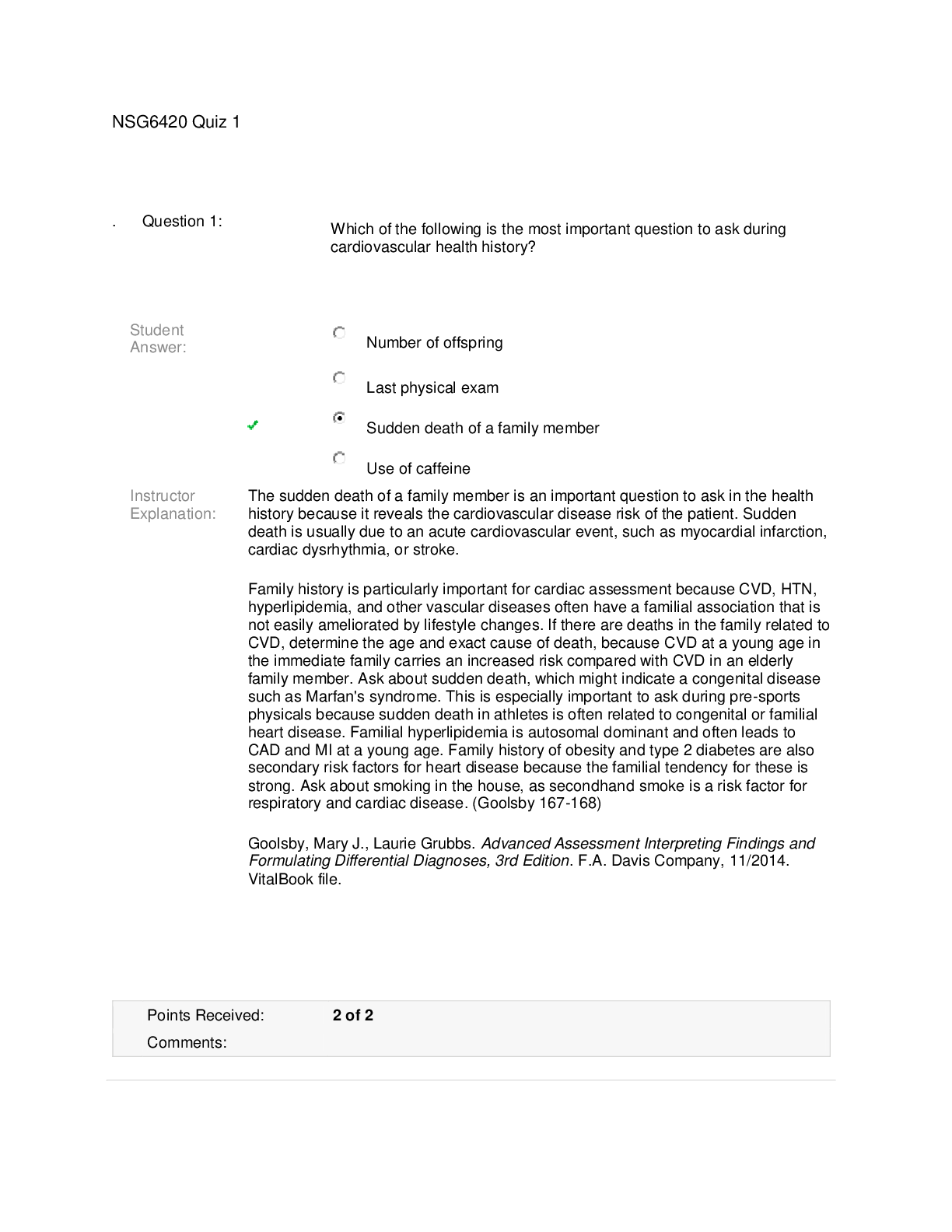
Reviews( 0 )
Document information
Connected school, study & course
About the document
Uploaded On
Aug 31, 2019
Number of pages
0
Written in
Additional information
This document has been written for:
Uploaded
Aug 31, 2019
Downloads
0
Views
33


